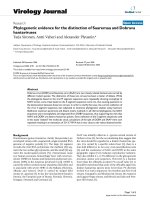Báo cáo sinh học: " Periodic solutions for a class of higher order difference equations" potx
Bạn đang xem bản rút gọn của tài liệu. Xem và tải ngay bản đầy đủ của tài liệu tại đây (197.85 KB, 14 trang )
This Provisional PDF corresponds to the article as it appeared upon acceptance. Fully formatted
PDF and full text (HTML) versions will be made available soon.
Periodic solutions for a class of higher order difference equations
Advances in Difference Equations 2011, 2011:66 doi:10.1186/1687-1847-2011-66
Huantao Zhu ()
Weibing Wang ()
ISSN 1687-1847
Article type Research
Submission date 16 September 2011
Acceptance date 23 December 2011
Publication date 23 December 2011
Article URL />This peer-reviewed article was published immediately upon acceptance. It can be downloaded,
printed and distributed freely for any purposes (see copyright notice below).
For information about publishing your research in Advances in Difference Equations go to
/>For information about other SpringerOpen publications go to
Advances in Difference
Equations
© 2011 Zhu and Wang ; licensee Springer.
This is an open access article distributed under the terms of the Creative Commons Attribution License ( />which permits unrestricted use, distribution, and reproduction in any medium, provided the original work is properly cited.
Perio dic solutions for a class of
higher-order difference equations
Huantao Zhu
1
and Weibing Wang
∗2
1
Hunan College of Information, Changsha, Hunan 410200, P.R. China
2
Department of Mathematics, Hunan University of Science and Technology,
Xiangtan, Hunan 411201, P.R. China
*Corresponding author:
Email address:
HZ:
Abstract
In this article, we discuss the existence of periodic solutions for the higher-
order difference equation
x(n + k) = g(x(n)) − f(n, x(n − τ(n)).
We show the existence of periodic solutions by using Schauder’s fixed point the-
orem, and illustrate three examples.
MSC 2010: 39A10; 39A12.
Keywords: functional difference equation; periodic solution; fixed point theo-
rem.
1
1 Introduction and main results
Let R denote the set of the real numbers, Z the integers and N the positive integers. In
this article, we investigate the existence of periodic solutions of the following high-order
functional difference equation
x(n + k) = g(x(n)) −f(n, x(n −τ(n)), n ∈ Z, (1.1)
where k ∈ N, τ : Z → Z and τ (n + ω) = τ(n), f(n + ω, u) = f(n, u) for any (n, u) ∈
Z × R, ω ∈ N.
Difference equations have attracted the interest of many researchers in the last
20 years since they provided a natural description of several discrete models, in which
the periodic solution problem is always a important topic, and the reader can consult
[1–7] and the references therein. There are many good results about existence of
periodic solutions for first-order functional difference equations [8–12]. Only a few
article have been published on the same problem for higher-order functional difference
equations. Recently, using coincidence degree theory, Liu [13] studied the second-order
nonlinear functional difference equation
∆
2
x(n − 1) = f(n, x(n − τ
1
(n)), x(n −τ
2
(n)), . . . , x(n − τ
m
(n))), (1.2)
and obtain sufficient conditions for the existence of at least one periodic solution of
equation (1.2). By using fixed point theorem in a cone, Wang and Chen [14] discussed
the following higher-order functional difference equation
x(n + m + k) −ax(n + m) − bx(n + k) + abx(n) = f(n, x(n −τ(n))), (1.3)
where a = 1, b = 1 are positive constants, τ : Z → Z and τ(n+ω) = τ (n), ω, m, k ∈ N,
and obtained existence theorem for single and multiple positive periodic solutions of
2
(1.3).
Our aim of this article is to study the existence of periodic solutions for the higher-
order difference equations (1.1) using the well-known Schauder’s fixed point theorem.
Our results extend the known results in the literature.
The main results of this article are following sufficient conditions which guarantee
the existence of a periodic solution for (1.1).
Theorem 1.1. Assume that there exist constants m < M, r > 0 such that g ∈
C
1
[m, M] with r ≤ g
(u) ≤ 1 for any u ∈ [m, M] and f (n, u) : Z × [m, M] → R
is continuous in u,
g(M) −M ≤ f(n, u) ≤ g(m) −m (1.4)
for any (n, u) ∈ Z × [m, M], then (1.1) has at least one ω-periodic solution x with
m ≤ x ≤ M.
Theorem 1.2. Assume that there exist constants m < M such that g ∈ C
1
[m, M] with
g
(u) ≥ 1 for any u ∈ [m, M] and f (n, u) : Z ×[m, M] → R is continuous in u,
g(m) −m ≤ f(n, u) ≤ g(M) − M (1.5)
for any (n, u) ∈ Z × [m, M], then (1.1) has at least one ω-periodic solution x with
m ≤ x ≤ M.
2 Some examples
In this section, we present three examples to illustrate our conclusions.
Example 2.1. Consider the difference equation
x(n + k) = ax(n) + q(n)
3
x(n − τ(n)), (2.1)
3
x(n + k) = bx(n) −q(n)
3
x(n − τ(n)), (2.2)
where k ∈ N, 0 < a < 1, b > 1, q is one ω-periodic function with q(n) > 0 for all
n ∈ [1, ω] and τ : Z → Z and τ(n + ω) = τ(n).
Let m > 0 be sufficiently small and M > 0 sufficiently large. It is easy to check
that
(a − 1)M ≤ −q(n)
3
√
u ≤ (a − 1)m,
(b − 1)m ≤ q(n)
3
√
u ≤ (b − 1)M
for n ∈ Z and u ∈ [m.M]. By Theorem 1.1 (Theorem 1.2), Equation (2.1) (or (2.2))
has at least one positive ω-periodic solution x with m ≤ x ≤ M. When k = 1, this
conclusion about (2.1) and (2.2) can been obtained from the results in [15]. Our result
holds for all k ∈ N.
Remark 1 Consider the difference equations
x(n + k) = ax(n) + q(n)f(x(n −τ(n))), (2.3)
x(n + k) = bx(n) −q(n)f(x(n −τ(n))), (2.4)
where k ∈ N, 0 < a < 1, b > 1, q is one ω-periodic function with q(n) > 0 for all
n ∈ [1, ω], τ : Z → Z and τ(n + ω) = τ(n) and f : (0, +∞) → (0, +∞) is continuous.
The following result generalizes the conclusion of Example 2.1.
Proposition 2.1 Assume that f
0
= +∞ and f
∞
= 0, here
f
0
= lim
u→0
+
f(u)
u
, f
∞
= lim
u→∞
f(u)
u
,
then (2.3) or (2.4) has at least one positive ω-periodic solution.
4
Proof Here, we only consider (2.3). From f
0
= +∞ and f
∞
= 0, we obtain that
there exist 0 < ρ
1
< ρ
2
such that
f(u) ≥
1 − a
min q(n)
u, 0 < u ≤ ρ
1
, f(u) ≤
1 − a
max q(n)
u, u ≥ ρ
2
.
Let A = min q(n) min{f(u) : ρ
1
≤ u ≤ ρ
2
} and B = max q(n) max{f(u) : ρ
1
≤ u ≤
ρ
2
}. Choosing θ ∈ (0, 1) such that
A
1 − a
≥ θρ
1
,
B
1 − a
≤ θ
−1
ρ
2
,
we obtain that
f(u) ≥
1 − a
min q(n)
u ≥
θ(1 −a)ρ
1
min q(n)
, θρ
1
≤ u ≤ ρ
1
,
f(u) ≤
θ
−1
(1 − a)ρ
2
max q(n)
, ρ
2
≤ u ≤ θ
−1
ρ
2
,
A ≤ q(n)f(u) ≤ B, ∀n ∈ Z, ρ
1
≤ u ≤ ρ
2
.
Using the above three inequalities, we have
(1 − a)θρ
1
≤ q(n)f(u) ≤ (1 −a)θ
−1
ρ
2
, ∀n ∈ Z, θρ
1
≤ u ≤ θ
−1
ρ
2
.
By Theorem 1.1, Equation (2.3) has at least one positive ω-periodic solution x with
θρ
1
≤ x ≤ θ
−1
ρ
2
.
Example 2.2. Consider the difference equation
x(n + k) = −
1
x
α
(n)
+ q(n), (2.5)
where k ∈ N, α > 0, q is one ω-periodic function.
We claim that there is a λ > 0 such that (2.5) has at least two positive ω-periodic
solutions for min q(n ) > λ.
5
In fact, g(x) = −x
−α
. Let 0 < a <
α+1
√
α be sufficiently small and b >
α+1
√
α be
sufficiently large, then
α
b
α+1
≤ g
(x) =
α
x
α+1
≤ 1, for x ∈ [
α+1
√
α, b],
g
(x) =
α
x
α+1
≥ 1, for x ∈ [a,
α+1
√
α].
If the following conditions are fulfilled
−
1
b
α
− b ≤ −q(n) ≤ −
1
α
α
√
α
− α
α
√
α, ∀n ∈ Z, (2.6)
−
1
a
α
− a ≤ −q(n) ≤ −
1
α
α
√
α
− α
α
√
α, ∀n ∈ Z, (2.7)
then (2.5) has at least one periodic solution in [a,
α+1
√
α] and [
α+1
√
α, b ] respectively.
When min q(n) is sufficiently large, the conditions (2.6) and (2.7) are satisfied.
Example 2.3. Consider the difference equation
x(n + k) = x
3
(n) − 2x(n) − q(n)x
2
(n − τ(n)), (2.8)
where k ∈ N, q is one ω-periodic function with q(n) > 0 for all n ∈ [1, ω], τ : Z → Z
and τ(n + ω) = τ(n).
Let m = 1,M > 3 + max q(n) and g(u) = u
3
− 2u, f(n, u) = q(n)u
2
. It is easy to
check that g
(u) ≥ 1 for u ∈ [m, M], and
g(m) −m = −2 < f(n, u) ≤ g(M) −M = M
3
− 3M, ∀n ∈ Z, u ∈ [m, M ].
By Theorem 1.2, Equation (2.8) has at least one positive ω-periodic solution x with
m ≤ x ≤ M.
Remark 2 Consider the difference equation
x(n + k) = g(x(n)) −q(n)f(x(n −τ(n))), (2.9)
6
where k ∈ N, q is one ω-periodic function with q(n) > 0 for all n ∈ [1, ω], τ : Z → Z
and τ(n + ω) = τ(n) and f : (0, +∞) → (0, +∞) is continuous.
Proposition 2.2 Assume that there exists a > 0 such that g ∈ C
1
([a, +∞), R)
with g
(u) ≥ 1 for u > a, f(u) ≥ (g(a) −a)/ min q(n) for u ≥ a. Further suppose that
lim
u→+∞
g(u) −u
f(u)
> max q (n), lim
u→+∞
(g(u) −u) = +∞.
Then (2.9) has at least one positive ω-periodic solution.
Proof There exist ρ > 0 such that
g(u) −u ≥ f(u) max q(n), u ≥ ρ.
Let A = min q(n) min{f(u) : a ≤ u ≤ ρ} and B = max q(n) max{f(u) : a ≤ u ≤ ρ}.
Since lim
u→+∞
(g(u) − u) = +∞ and g
(u) ≥ 1 for u > a, there is M > ρ such that
g(M) −M > B and
f(u) max q (n) ≤ g(u) −u ≤ g( M ) − M, ρ ≤ u ≤ M.
Thus, (2.9) has at least one ω-periodic solution x with a ≤ x ≤ M.
3 Proof
Let X be the set of all real ω-periodic sequences. When endowed with the maximum
norm x = max
n∈[0,ω−1]
|x(n)|, X is a Banach space.
Let k ∈ N and 0 < c = 1, and consider the equation
x(n + k) = cx(n) + γ(n), (3.1)
7
where γ ∈ X. Set (k, ω) is the greatest common divisor of k and ω, h = ω/(k, ω). We
obtain that if x ∈ X satisfies (3.1), then
c
−1
x(n + k) −x(n) = c
−1
γ(n),
c
−2
x(n + 2k) −c
−1
x(n + k) = c
−2
γ(n + k),
············
c
−p
x(n + hk) −c
1−p
x(n + (h − 1)k) = c
−p
γ(n + (h − 1)k).
By summing the above equations and using periodicity of x, we obtain the following
result.
Lemma 3.1. Assume that 0 < c = 1, then (3.1) has a unique periodic solution
x(n) = (c
−h
− 1)
−1
h
i=1
c
−i
γ(n + (i − 1)k).
The following well-known Schauder’s fixed point theorem is crucial in our argu-
ments.
Lemma 3.2. [16] Let X be a Banach space with D ⊂ X closed and convex. Assume
that T : D → D is a completely continuous map, then T has a fixed point in D.
Now, we rewrite (1.1) as
x(n + k) = px(n) + [g(x(n)) −f(n, x(n −τ(n)) −px(n)], (3.2)
where p > 0 is a constant which is determined later. By Lemma 3.1, if x is a periodic
solution of (1.1), x satisfies
x(n) = (p
−h
− 1)
−1
h
i=1
p
−i
(H
p
x)(n + (i − 1)k),
8
where h = ω/(k, ω), the mapping H
p
is defined as
(H
p
x)(n) = g(x(n)) −px(n) − f(n, x(n − τ(n)), x ∈ X.
Define a mapping T
p
in X by
(T
p
x)(n) = (p
−h
− 1)
−1
h
i=1
p
−i
(H
p
x)(n + (i − 1)k), x ∈ X.
Clearly, the fixed point of T
p
in X is a periodic solution of (1.1).
Proof of Theorem 1.1 Let p = r and Ω = {x ∈ X : m ≤ x(n) ≤ M for n ∈ Z},
then Ω is a closed and convex set. If r = 1, then g(u) ≡ u on [m, M]. It is easy to
check that any constant c ∈ [m, M] is a periodic solution of (1.1). Set r < 1. Now we
show that T
r
satisfies all conditions of Lemma 3.2. Noting that the function g(u) −ru
is nondecreasing in [m, M], we have for any x ∈ Ω,
g(m) −rm ≤ g(x(n)) −rx(n) ≤ g(M) −rM, ∀n ∈ Z.
Let (2.1) be fulfilled. For any x ∈ Ω and n ∈ Z,
(H
r
x)(n) = g(x(n)) −px(n) − f(n, x(n − τ(n)
≤ g(M) −rM − (g(M) −M)
= (1 − r)M,
(H
r
x)(n) = g(x(n)) −px(n) − f(n, x(n − τ(n)
≥ g(m) − rm −(g(m) −m)
= (1 − r)m.
9
Hence, for any x ∈ Ω and n ∈ Z,
(T
r
x)(n) = (r
−h
− 1)
−1
h
i=1
r
−i
(H
p
x)(n + (i − 1)k)
≤ (r
−h
− 1)
−1
h
i=1
r
−i
(1 − r)M = M,
(T
r
x)(n) = (r
−h
− 1)
−1
h
i=1
r
−i
(H
p
x)(n + (i − 1)k)
≥ (r
−h
− 1)
−1
h
i=1
r
−i
(1 − r)m = m.
Hence, T
r
(Ω) ⊆ Ω.
Since X is finite-dimensional and g(u), f(n, u) are continuous in u, one easily show
that T
r
is completely continuous in Ω. Therefore, T
r
has a fixed point x ∈ Ω by Lemma
3.2, which is a ω-periodic solution of (1.1). The proof is complete.
Proof of Theorem 1.2 Since g ∈ C
1
[m, M], max{g
(u) : m ≤ u ≤ M} exists and
max{g
(u) : m ≤ u ≤ M} ≥ 1. Let p = max{g
(u) : m ≤ u ≤ M}. If p = 1, then
g(u) ≡ u on [m, M]. It is easy to check that any constant c ∈ [m, M] is a periodic
solution of (1.1). Next, we assume that p > 1. Set Ω = {x ∈ X : m ≤ x(n) ≤
M for n ∈ Z}. Noting that the function g(u) − pu is nonincreasing in [m, M], we have
for any x ∈ Ω,
g(M) −pM ≤ g(x(n)) −px(n) ≤ g(m) −pm, ∀n ∈ Z.
10
For any x ∈ Ω and n ∈ Z,
(H
p
x)(n) = g(x(n)) −px(n) − f(n, x(n − τ(n)
≤ g(m) − pm − (g(m) −m)
= (1 − p)m,
(H
p
x)(n) = g(x(n)) −px(n) − f(n, x(n − τ(n)
≥ g(M) −pM − (g(M) −M)
= (1 − p)M.
Hence, for any x ∈ Ω and n ∈ Z,
(T
p
x)(n) = (p
−h
− 1)
−1
h
i=1
p
−i
(H
p
x)(n + (i − 1)k)
≥ (p
−h
− 1)
−1
h
i=1
p
−i
(1 − p)m = m,
(T
p
x)(n) = (p
−h
− 1)
−1
h
i=1
p
−i
(H
p
x)(n + (i − 1)k)
≤ (p
−h
− 1)
−1
h
i=1
p
−i
(1 − p)M = M.
Hence, T
p
(Ω) ⊆ Ω. T
p
has a fixed point x ∈ Ω. The proof is complete.
Competing interests
The authors declare that they have no competing interests.
Authors’ contributions
All authors contributed equally to the manuscript and read and approved the final
manuscript.
11
Acknowledgments
The authors would like to thank the referee for the comments which help to improve
the article. The study was supported by the NNSF of China (10871063) and Scientific
Research Fund of Hunan Provincial Education Department (10B017).
References
[1] Agarwal, RP: Difference Equations and Inequalities, 2nd edn. Marcel Dekker, New
York (2000)
[2] Antonyuk, PN, Stanyukovic, KP: Periodic solutions of the logistic difference equa-
tion. Rep. Acad. Sci. USSR 313, 1033–1036 (1990)
[3] Berg, L: Inclusion theorems for non-linear difference equations with applications.
J. Differ. Equ. Appl. 10, 399-408 (2004)
[4] Cheng, S, Zhang, G: Positive periodic solutions of a discrete population model.
Funct. Differ. Equ. 7, 223–230 (2000)
[5] Zheng, B: Multiple periodic solutions to nonlinear discrete Hamiltonian systems.
Adv. Differ. Equ. (2007). doi:10.1155/2007/41830
[6] Zhu, B, Yu, J: Multiple positive solutions for resonant difference equations. Math.
Comput. Model. 49, 1928–1936 (2009)
[7] Zhang, X, Wang, D: Multiple periodic solutions for difference equations with dou-
ble resonance at infinity. Adv. Differ. Equ. (2011). doi:10.1155/2011/806458
12
[8] Chen, S: A note on the existence of three positive periodic solutions of functional
difference equation. Georg. Math. J. 18, 39–52 (2011)
[9] Gil’, MI, Kang, S, Zhang, G: Positive periodic solutions of abstract difference
equations. Appl. Math. E-Notes 4, 54–58 (2004)
[10] Jiang, D, Regan, DO, Agarwal, RP: Optimal existence theory for single and mul-
tiple positive periodic solutions to functional difference equations. Appl. Math.
Comput. 161, 441–462 (2005)
[11] Padhi, S, Pati, S, Srivastava, S: Multiple positive periodic solutions for nonlinear
first order functional difference equations. Int. J. Dyn. Syst. Differ. Equ. 2, 98–114
(2009)
[12] Raffoul, YN, Tisdell, CC: Positive periodic solutions of functional discrete systems
and population model. Adv. Differ. Equ. 2005, 369–380 (2005)
[13] Liu, Y: Periodic solutions of second order nonlinear functional difference equations.
Archivum Math. 43, 67–74 (2007)
[14] Wang, W, Chen, X: Positive periodic solutions for higher order functional differ-
ence equations. Appl. Math. Lett. 23, 1468–1472 (2010)
[15] Raffoul, YN: Positive periodic solutions of nonlinear functional difference equa-
tions. Electron. J. Differ. Equ. 2002, 1–8 (2002)
[16] Guo, D, Lakshmikantham, V: Nonlinear Problem in Abstract Cones. Academic
Press, New York (1988)
13









